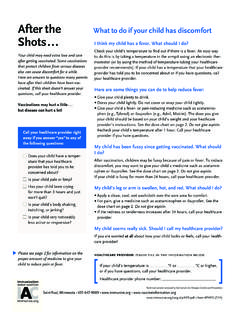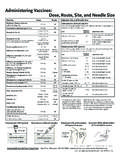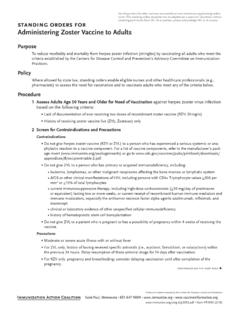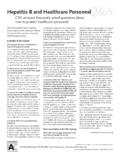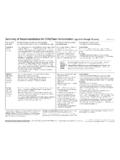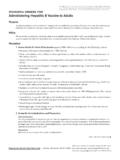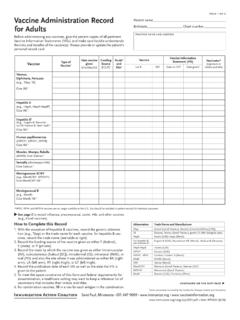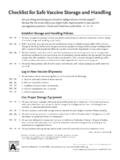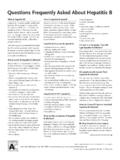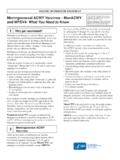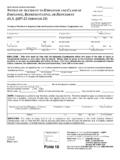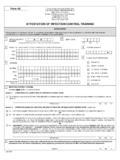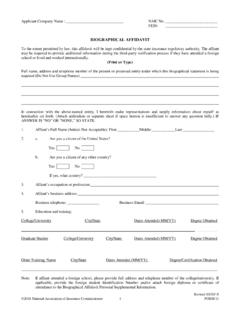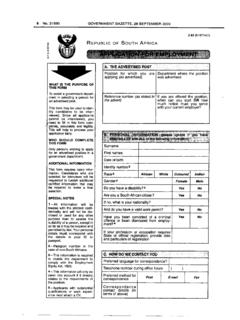Transcription of Guide to Contraindications and Precautions to Commonly ...
1 Guide to Contraindications and Precautions to Commonly Used Vaccines1,*. Vaccine Contraindications Precautions Hepatitis B (HepB) Severe allergic reaction ( , anaphylaxis) after a previ- Moderate or severe acute illness with or without fever ous dose or to a vaccine component Infant weighing less than 2000 grams (4 lbs, oz)2. Hypersensitivity to yeast Rotavirus Severe allergic reaction ( , anaphylaxis) after a previ- Moderate or severe acute illness with or without fever (RV5 [RotaTeq], ous dose or to a vaccine component Altered immunocompetence other than SCID. RV1 [Rotarix]) Severe combined immunodeficiency (SCID) Chronic gastrointestinal disease3. History of intussusception Spina bifida or bladder exstrophy3. Diphtheria, tetanus, Severe allergic reaction ( , anaphylaxis) after a previ- Moderate or severe acute illness with or without fever pertussis (DTaP) ous dose or to a vaccine component Guillain-Barr syndrome (GBS) within 6 weeks after a previous dose of teta- For pertussis-containing vaccines: Encephalopathy nus toxoid-containing vaccine Tetanus, diphtheria, ( , coma, decreased level of consciousness, pro- History of Arthus-type hypersensitivity reactions after a previous dose of pertussis (Tdap) longed seizures) not attributable to another identifiable diphtheria- or tetanus-toxoid-containing vaccine.
2 Defer vaccination until at cause within 7 days of administration of a previous least 10 years have elapsed since the last tetanus-toxoid containing Tetanus, diphtheria dose of DTP or DTaP (for DTaP); or of previous dose of vaccine (DT, Td) DTP, DTaP, or Tdap (for Tdap) For DTaP and Tdap only: Progressive or unstable neurologic disorder (including infantile spasms for DTaP), uncontrolled seizures, or progres- sive encephalopathy; defer until a treatment regimen has been established and the condition has stabilized Haemophilus influenzae Severe allergic reaction ( , anaphylaxis) after a previ- Moderate or severe acute illness with or without fever type b (Hib) ous dose or to a vaccine component Age younger than 6 weeks Inactivated poliovirus Severe allergic reaction ( , anaphylaxis) after a previ- Moderate or severe acute illness with or without fever vaccine (IPV) ous dose or to a vaccine component Pregnancy Hepatitis A (HepA) Severe allergic reaction ( , anaphylaxis) after a previ- Moderate or severe acute illness with or without fever ous dose or to a vaccine component Measles, mumps, Severe allergic reaction ( , anaphylaxis) after a previ- Moderate or severe acute illness with or without fever rubella (MMR)
3 4 ous dose or to a vaccine component Recent (within 11 months) receipt of antibody-containing blood product Severe immunodeficiency ( , hematologic and solid (specific interval depends on product)7. tumors, chemotherapy, congenital immunodeficiency For MMRV only: Family history of seizures or long-term immunosuppressive therapy5), or per- History of thrombocytopenia or thrombocytopenic purpura sons with human immunodeficiency virus [HIV] infec- Need for tuberculin skin testing8. tion who are severely immunocompromised6. Family history of congenital or hereditary immunodefi- ciency in first-degree relatives ( , parents and sib- lings), unless the immune competence of the potential vaccine recipient has been substantiated clinically or verified by a laboratory test Pregnancy Varicella (Var)4 Severe allergic reaction ( , anaphylaxis) after a previ- Moderate or severe acute illness with or without fever ous dose or to a vaccine component Recent (within 11 months) receipt of antibody-containing blood product Severe immunodeficiency ( , hematologic and solid (specific interval depends on product)7.)
4 Tumors, chemotherapy, congenital immunodeficiency Receipt of specific antivirals ( , acyclovir, famciclovir, or valacyclovir) 24. or long-term immunosuppressive therapy5), or per- hours before vaccination; avoid use of these antiviral drugs for 14 days sons with HIV infection who are severely after vaccination. immunocompromised6. Family history of congenital or hereditary immunodefi- ciency in first-degree relatives ( , parents and sib- lings), unless the immune competence of the potential vaccine recipient has been substantiated clinically or verified by a laboratory test Pregnancy continued on the next page . Technical content reviewed by the Centers for Disease Control and Prevention Saint Paul, Minnesota 651- 647- 9009 Item #P3072a (9/18). Guide to Contraindications and Precautions to Commonly Used Vaccines1,* (continued) PAGE 2 OF 2.
5 Vaccine Contraindications Precautions Pneumococcal Severe allergic reaction ( , anaphylaxis) after a previous Moderate or severe acute illness with or without fever (PCV13 or PPSV23) dose or to a vaccine component (including, for PCV13, to any diphtheria toxoid-containing vaccine). Influenza, inactivated Severe allergic reaction ( , anaphylaxis) to any compo- Moderate or severe acute illness with or without fever injectable (IIV)9 nent of the vaccine (except egg) or to a previous dose of History of GBS within 6 weeks of previous influenza vaccination influenza vaccine9 Egg allergy other than hives ( , angioedema, respiratory distress, lightheadedness, or recurrent emesis); or required epinephrine or another emergency medical intervention (IIV may be administered in an inpatient or outpatient medical setting, under the supervision of a healthcare provider who is able to recognize and manage severe allergic conditions)9.
6 Influenza, recombinant Severe allergic reaction ( , anaphylaxis) to any compo- Moderate or severe acute illness with or without fever (RIV)9 nent of the vaccine (except egg) or to a previous dose of History of GBS within 6 weeks of previous influenza vaccination influenza vaccine9. Influenza, live attenuated Severe allergic reaction ( , anaphylaxis) to any component of the Moderate or severe acute illness with or without fever (LAIV)2,3 vaccine (except egg) or to a previous dose of influenza vaccine GBS within 6 weeks of previous influenza vaccination Concomitant use of aspirin or salicylate-containing therapy in chil- Asthma in persons age 5 years and older dren or adolescents Other chronic medical conditions ( , other chronic lung diseases, Children age 2 through 4 years who have a diagnosis of asthma or chronic cardiovascular disease [excluding isolated hypertension], diabetes, had wheezing with the past 12 months, per healthcare provider chronic renal or hepatic disease, hematologic disease, neurologic disease, statement and metabolic disorders).
7 Children and adults who are immunocompromised due to any cause (including immunosuppression caused by medications or by HIV. infection). Close contacts and caregivers of severely immunosuppressed per- sons who required a protected environment). Pregnancy Receipt of influenza antivirals (amantadine, rimantadine, zanami- vir, oseltamivir or peramivir) within the previous 48 hours; avoid use of these antiviral drugs for 14 days after vaccination Human papillomavirus Severe allergic reaction ( , anaphylaxis) after a previous Moderate or severe acute illness with or without fever (HPV) dose or to a vaccine component Pregnancy Meningococcal Severe allergic reaction ( , anaphylaxis) after a previous Moderate or severe acute illness with or without fever (MenACWY; MenB) dose or to a vaccine component footnotes 1.
8 The Advisory Committee on Immunization Practices (ACIP) recommendations and package 6. HIV-infected children 5 years of age or younger should receive measles vaccine if CDT+ T-lym- inserts for vaccines provide information on Contraindications and Precautions related to vac- phocyte percentages are greater than or equal to 15% for greater than or equal to 6 months. cines. Contraindications are conditions that increase chances of a serious adverse reaction in HIV-infected children older than 5 years must have CD4+ percentages greater than or equal to vaccine recipients and the vaccine should not be administered when a contraindication is pres- 15 and CD4+ T-lymphocyte counts greater than or equal to 200 lymphocytes/cubic mm for 6. ent. Precautions should be reviewed for potential risks and benefits for vaccine recipient.
9 For a months or longer. In cases where only counts or only percentages are available for children person with a severe allergy to latex ( , anaphylaxis), vaccines supplied in vials or syringes older than 5 years, use the data that are available. In cases where percentages are not available that contain natural rubber latex should not be administered unless the benefit of vaccination for children 5 years of younger, use counts based on the age-specific counts at the time the clearly outweighs the risk for a potential allergic reaction. For latex allergies other than anaphy- counts were measured (see for details). HIV- laxis, vaccines supplied in vials or syringes that contain dry, natural rubber or natural rubber infected children younger than 8 years may receive varicella vaccine if CD4+ T-lymphocyte per- latex may be administered.
10 Whether and when to administer DTaP to children with proven or centages are 15% or greater. HIV-infected children 8 years or older may receive varicella vaccine suspected underlying neurologic disorders should be decided on a case-by-case basis. if CD4+ T-lymphocyte count is greater than 200 cells/cubic mm. 2. Hepatitis B vaccination should be deferred for preterm infants and infants weighing less than 7. Vaccine should be deferred for the appropriate interval if replacement immune globulin products are 2000 g if the mother is documented to be hepatitis B surface antigen (HBsAg)-negative at the being administered (see Table 3-5. Recommended Intervals Between Administration of Anti- time of the infant's birth. Vaccination can commence at chronological age 1 month or at hospi- body-Containing Products and Measles- or Varicella-Containing Vaccine, by Product and Indica- tal discharge.)
